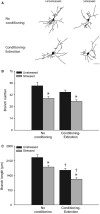Fear extinction deficits following acute stress associate with increased spine density and dendritic retraction in basolateral amygdala neurons
- PMID: 23714419
- PMCID: PMC3773716
- DOI: 10.1111/ejn.12259
Fear extinction deficits following acute stress associate with increased spine density and dendritic retraction in basolateral amygdala neurons
Abstract
Stress-sensitive psychopathologies such as post-traumatic stress disorder are characterized by deficits in fear extinction and dysfunction of corticolimbic circuits mediating extinction. Chronic stress facilitates fear conditioning, impairs extinction, and produces dendritic proliferation in the basolateral amygdala (BLA), a critical site of plasticity for extinction. Acute stress impairs extinction, alters plasticity in the medial prefrontal cortex-to-BLA circuit, and causes dendritic retraction in the medial prefrontal cortex. Here, we examined extinction learning and basolateral amygdala pyramidal neuron morphology in adult male rats following a single elevated platform stress. Acute stress impaired extinction acquisition and memory, and produced dendritic retraction and increased mushroom spine density in basolateral amygdala neurons in the right hemisphere. Unexpectedly, irrespective of stress, rats that underwent fear and extinction testing showed basolateral amygdala dendritic retraction and altered spine density relative to non-conditioned rats, particularly in the left hemisphere. Thus, extinction deficits produced by acute stress are associated with increased spine density and dendritic retraction in basolateral amygdala pyramidal neurons. Furthermore, the finding that conditioning and extinction as such was sufficient to alter basolateral amygdala morphology and spine density illustrates the sensitivity of basolateral amygdala morphology to behavioral manipulation. These findings may have implications for elucidating the role of the amygdala in the pathophysiology of stress-related disorders.
Keywords: amygdala; dendritic spine; emotional learning; rat.
Published 2013. This article is a U.S. Government work and is in the public domain in the USA.
Figures





References
-
- Akirav I, Segev A, Motanis H, Maroun M. D-cycloserine into the BLA reverses the impairing effects of exposure to stress on the extinction of contextual fear, but not conditioned taste aversion. Learn. Memory. 2009;16:682–686. - PubMed
-
- Berridge CW, Mitton E, Clark W, Roth RH. Engagement in a non-escape (displacement) behavior elicits a selective and lateralized suppression of frontal cortical dopaminergic utilization in stress. Synapse. 1999;32:187–197. - PubMed
-
- Blanchard DC, Blanchard RJ. Innate and conditioned reactions to threat in rats with amygdaloid lesions. J. Comp. Physiol. Psych. 1972;81:281–290. - PubMed
Publication types
MeSH terms
Grants and funding
LinkOut - more resources
Full Text Sources
Other Literature Sources

